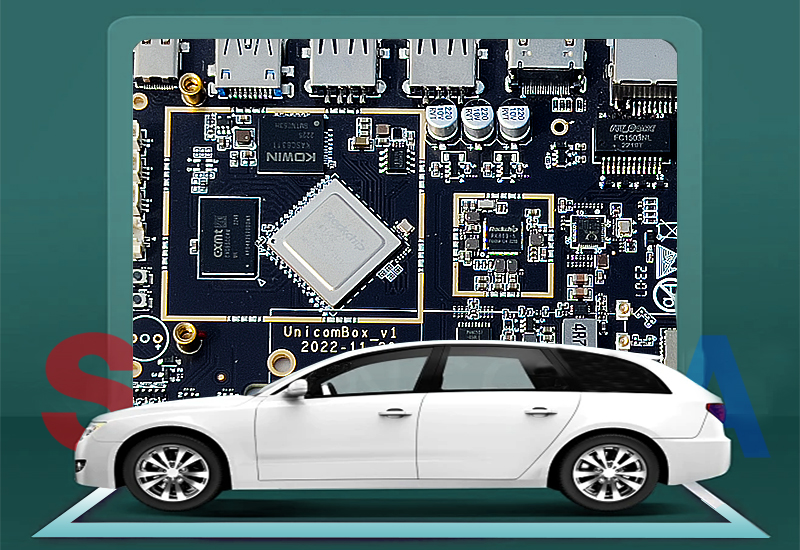
Automotive electronics PCBA is a circuit board specially designed for automotive electronic systems. The automotive printed circuit board design and manufacturing must comply with strict automotive industry standards and specifications to ensure their reliability and safety in auto electronic systems. PCBA boards connect and support various electronic components and parts in automobiles. These electronic components include engine controls, body electronic systems, safety devices, etc. Automotive electronic circuit boards carry the vehicle's electrical system functions and play an important role in connecting and conducting current signals. Typically, vehicle PCB assembly boards are composed of fiberglass-reinforced resin substrates and metal conductor layers. High-precision automotive PCBAs optimize your vehicle's performance to cope with vibrations, temperature changes, and other harsh driving conditions.
In the automotive electronics field, the PCB assembly design and manufacturing is mainly used in:
● Car driving control system
● Vehicle electronic systems
● Automotive inverter
● Auto Battery management system
● Automotive pressure sensing detection system
● Charging pile control system
● Car light control system
● Vehicle embedded system
● Car entertainment system
● Vehicle lights
● Car driving assistance system
● Vehicle infotainment system
● Auto navigation system
● Automotive power control system
These application areas cover all aspects of the vehicle, from driving control to entertainment systems, and require PCBA support to realize their functions.
Automobile electronics is a complex mechanical device that highly relies on electronic systems. It operates stably for a long time in various harsh working environments. Therefore, auto circuit boards must have high reliability and can operate stably in harsh environments such as high temperature, humidity, and vibration, as so can withstand heavy loads for a long time
Due to limited car space, automotive PCB assembly requires a compact design. To meet the special space requirements, automobile circuit boards usually adopt multi-layer structures.
Multi-layer structures can achieve higher integration and more complex circuit connections in limited space. A multi-layer circuit board is composed of multiple layers, and each layer is connected through plated holes. This design can reduce the size of the circuit board, allowing more circuits to be placed in a limited space. At the same time, the multi-layer structure can also improve signal transmission speed and anti-interference ability.
Automotive PCB assembly needs to be able to withstand harsh conditions such as high temperatures and vibration. Therefore, the material selection of automotive circuit boards is very important and needs to have excellent insulation properties, high-temperature resistance, chemical corrosion resistance, and aging resistance.
· High-temperature resistance
Automotive circuit boards usually use high-temperature-resistant base materials, such as polyimide (PI) or polytetrafluoroethylene (PTFE). These materials have high glass transition temperatures and thermal stability and can maintain stable electrical properties and mechanical strength in high temperature environments.
· Vibration resistance
Auto PCBA boards need to choose materials with good mechanical strength and vibration resistance. Common choices include fiberglass-reinforced epoxy (FR-4) and polyimide (PI), among others. These materials have high strength and rigidity and can effectively resist shock and vibration during car driving.
By meeting electromagnetic compatibility requirements, automotive PCB components can ensure their normal operation in complex electromagnetic environments and ensure the automotive electronic systems' reliability and stability.
Automotive PCB assembly requires measures to suppress the generation of electromagnetic interference, such as using shielding covers, electromagnetic shielding materials, etc. At the same time, they need to undergo strict electromagnetic compatibility testing to ensure that it can work properly in the environment.

High-precision PCBA design can achieve more efficient power management, including battery management, voltage stability, and current control. This can improve the vehicle's energy utilization, extend battery life, and ensure the stable operation of electronic devices.
PCB assembly manufacturing can integrate various sensors and control systems, such as inertial measurement units (IMU), vehicle stability control systems, autonomous driving systems, etc. These systems can provide more accurate data and more precise control, improving vehicle safety and performance.
PCB assembly can support multiple communication protocols and connectivity options such as Bluetooth, Wi-Fi, CAN bus, etc. This can achieve a seamless connection between the vehicle and external devices, providing more functions and services, such as in-car entertainment systems, navigation systems, remote monitoring, etc.
Advanced PCBA manufacturing technology can integrate fault diagnosis systems and remote monitoring functions. By monitoring and analyzing vehicle data in real-time, problems can be discovered and solved promptly, improving vehicle reliability and maintenance efficiency.
Reliable PCBA services can help vehicles achieve energy conservation and environmental protection by optimizing circuit design and energy management. For example, intelligent control systems optimize engine combustion efficiency and reduce emissions and fuel consumption.
Since printed circuit boards in the automotive electronics field are characterized by multiple varieties and small batches, production costs are high due to model changes and parameter adjustments during the production process. SCSPCBA has accumulated rich experience in the field of automotive PCBA manufacturing. The following is experience sharing:
By formulating standardized PCBA design specifications and PCB assembly process, using PCBA with the same technical specifications, stacking structure, and production parameters as the basic conditions, reducing the number of model changes and parameter adjustments, and improving the production efficiency of automotive circuit boards.
The intelligent ERP system can automatically filter, screen, classify, and combine orders. By integrating with the ERP system, SCSPCBA automatically merges small batch orders of multiple models to form medium and large batch orders based on the system's automotive pcba order quantity, delivery date and other information. This can improve production efficiency and reduce production costs.
● Automated Production Equipment
SCSPCBA keeps pace with the times and introduces automated production equipment, such as automatic patch machines, automatic welding machines, etc., to achieve fast and accurate assembly and welding, reduce manual operation time and errors, and further improve PCB production efficiency .
SCSPCBA has established close cooperative relationships with suppliers in PCBA assembly to ensure the timely supply of required materials and components. This avoids interruptions in automotive PCBA production and increased costs caused by material shortages or delays.
